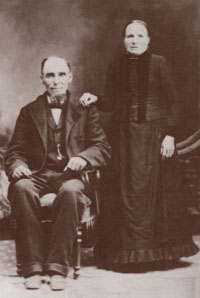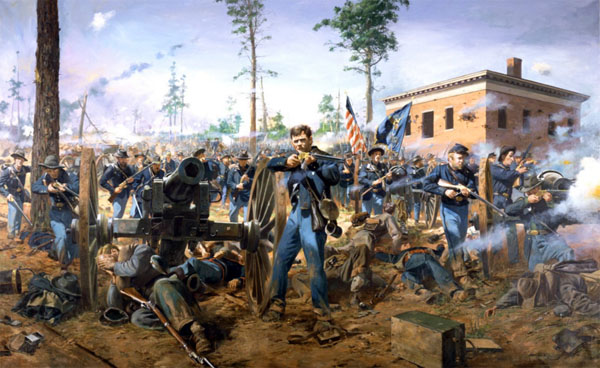 Johann and Caroline Tiedt
Johann and Caroline Tiedt
 Johann and Caroline Tiedt
Johann and Caroline Tiedt
Johann Heinrich Tiedt was born in Penzin Sternburg Mecklenburg Schwerin, Germany on 3 May 1838 to Johann Christian and Catharina Margarethe Maria Auguste "Lena" (Zierjack) Tiedt, the daughter of Heinrich Georg and Catharina Margaretha Elizabeth (Bössow) Zierjack.
According to the Civil War Pension Index, Johann served in Battery 'H', 1st Illinois Light Artillary. In his letter to Gertrude Meyer in December 1998, researcher Don Leistikow mentions that Johann's service in the Artillery was brief. According to a newspaper article received by Carl Tiedt, Johann was "gassed, disabled, and discharged" in August, 1862. (I was not able to locate any information on the use of poisonous gas in the Civil War, though apparently it had been proposed for use.)
Caroline Rackow was born in Garste, Pomerania on 24 Aug 1835
Johann (often referred to as John) married Caroline on April 16, 1865, and they had 8 children:
| Johann F Tiedt |
| Elizabeth Lizzie Tiedt |
| Elise Tiedt |
| Rosalie Louise Tiedt |
| Pauline Tiedt |
| Bertha Sophia Tiedt |
| Ida Tiedt |
| Albert Friedrich Tiedt |
According to a story related by one of Leopold Leistikow's grandchildren, Leopold was friends with Johann. They were from the same geopraphic area, both of German descent, and both were serving in the Civil War. When Leopold was mustered out of the army in 1864, he had nowhere to live. Johann suggested he stay with his family, and told Leopold he had many sisters, one of whom might interest Leopold. Whether or not this story is true, Leopold Leistikow ended up marrying one of Johann's sisters, Dorothea. If you follow the link to the webpage of Leopold Leistikow, you'll see (at the bottom) a 1917 map showing the property owned by Johann's son, Johann Tiedt, Jr., his only son that survived to adulthood. This was likely the land that Johann farmed. It is about a mile north of the farm of Leopold Leistiko and Johann's sister Dorothea.
Johann died March 30, 1893, and Caroline applied for, and received, a Civil War veterans pension. The follow translation of his obituary from "The Phoenix" the German language newspaper, published in Bremer County, Iowa March 30,1895, reads, "Once again, one of the old German Farmers of Maxfield has died. Johann Tiedt, who was not yet 55, died last Thursday afternoon of consumption. The departed was born on May 3,1838, in Bueschow, Mecklenburg-Schwerin. He left his old fatherland in May 1855 and immigrated to America. He lived with his parents for 5 years in Manitowoc, Wisconsin. From there he moved to Addison, Du Page County, Illinois. When the bloody Civil War broke out, he enlisted on February 27,1862, and became a member of Company H of the First Regiment of the Illinois Light Artillery. He remained in active service until August 4,1862, when he was honorably discharged on account of lung and stomach trouble. As a result of the depravation and strain of his service, his lungs were damaged. This ultimately led to the consumption that brought on his death. He was treated for a long time in Paducah, Kentucky, and in the Marine Hospital in Chicago. ... He was one of the best members of the St. Matthews Church and one of the best citizens of Bremer County."
Caroline died March 1, 1925.
